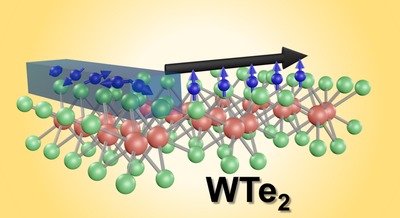小さなスケールで興味深い物質の挙動を発見することで、コンピューティングに必要なエネルギーを削減できる可能性があります。 Discovery of intriguing material behavior at small scales could reduce energy demands for computing.
2022-10-19 アルゴンヌ国立研究所(ANL)

A representation of a two-dimensional ferroelectric material. (Image by UC Berkeley/Suraj Cheema.)
さらに、この強誘電体の振る舞いは、原子レベルの厚さである約0.5ナノメートルまで継続することを明らかにした。これは、世界で最も薄い強誘電体であることを示す画期的な成果である。
研究者らは、この極薄材料の分極を小さな電圧で前後に切り替えることにも成功し、シリコン上で報告されたワーキングメモリの中で最も薄いデモンストレーションを可能にした。また、従来の二酸化ジルコニウムがすでに現在の最先端シリコンチップに含まれていることを考えると、エネルギー効率の高い電子機器への応用も期待できる。
<関連情報>
- https://www.anl.gov/article/thinnest-ferroelectric-material-ever-paves-the-way-for-new-energyefficient-devices
- https://www.science.org/doi/10.1126/science.abm8642
シリコン上のサブナノメータ酸化物薄膜における創発的な強誘電性 Emergent ferroelectricity in subnanometer binary oxide films on silicon
Suraj S. Cheema,Nirmaan Shanker,Shang-Lin Hsu,Yoonsoo Rho,Cheng-Hsiang Hsu,Vladimir A. Stoica,Zhan Zhang,John W. Freeland,Padraic Shafer,Costas P. Grigoropoulos,Jim Ciston,Sayeef Salahuddin
Science published:5 May 2022
DOI: 10.1126/science.abm8642
Ultrathin ferroelectric films
The electrical properties of ferroelectrics can be changed with an electric field, making them attractive materials for computer hardware applications. Cheema et al. show that extremely thin films of zirconium dioxide on a silica substrate have ferroelectric order down to the unit cell scale. Whereas in many other materials the ferroelectric behavior is suppressed at the few-nanometer scale, a ferroelectric phase transition occurs if zirconium dioxide is thinner than two nanometers. This property might be true for any fluorite-structured binary oxide, making these types of thin films attractive for next-generation electronics. —BG
Abstract
The critical size limit of voltage-switchable electric dipoles has extensive implications for energy-efficient electronics, underlying the importance of ferroelectric order stabilized at reduced dimensionality. We report on the thickness-dependent antiferroelectric-to-ferroelectric phase transition in zirconium dioxide (ZrO2) thin films on silicon. The emergent ferroelectricity and hysteretic polarization switching in ultrathin ZrO2, conventionally a paraelectric material, notably persists down to a film thickness of 5 angstroms, the fluorite-structure unit-cell size. This approach to exploit three-dimensional centrosymmetric materials deposited down to the two-dimensional thickness limit, particularly within this model fluorite-structure system that possesses unconventional ferroelectric size effects, offers substantial promise for electronics, demonstrated by proof-of-principle atomic-scale nonvolatile ferroelectric memory on silicon. Additionally, it is also indicative of hidden electronic phenomena that are achievable across a wide class of simple binary materials.



